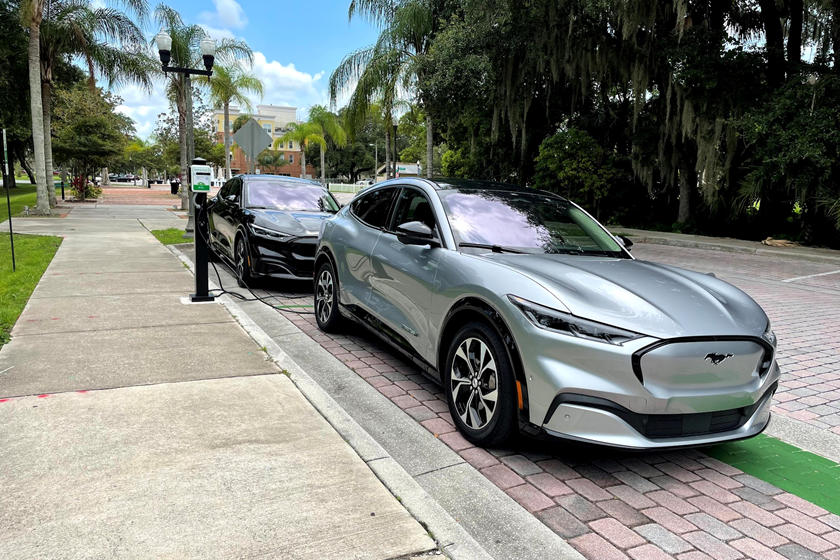By Jared Rosenholtz
We keep hearing that electric cars are the future. Around the globe, countries have committed to banning gasoline vehicle sales by a specific date, and the United States is under pressure to do the same. The current administration wants to cut greenhouse emissions in half by 2030, which involves getting more people to drive EVs. There’s a problem though. The charging infrastructure isn’t up to the task. At least not yet.
We recently tested the 2021 Ford Mustang Mach-E, an EV with a generous 270-mile range in all-wheel-drive extended range configuration. Our one-week test took place in Central Florida, out of an apartment building with no place to charge an EV in the parking garage. This became the perfect opportunity to see what EV ownership is like if you rely solely on public charging. As it turns out, it’s a nightmare.
While the Mach-E was our guinea pig for this experience, we want to make it clear that any non-Tesla EV would have fared equally, and none of our criticisms are directed at Ford. We also want to clarify that this article only covers our experience with public charging in Central Florida, and your results may vary.
Two Strikes
Though our building doesn’t have EV chargers, the apartment complex/shopping center across the street has two plugs operated by Greenlots. They aren’t DC fast chargers, but they are less than a five-minute walk and came in handy when we tested the Volkswagen ID.4. Unfortunately, when we went to plug in the Mach-E, the station would not start charging. The issue required a phone call to Greenlots, who confirmed that both plugs were offline. A work order was in place to repair them, but the attendant on the phone could not confirm when this would occur. Strike one for public charging.
With our closest charging station closed for the foreseeable future, we spotted another one at a local German car dealership down the street, this one operated by Chargepoint. As with the first charger, this one would not begin charging, but for a different reason. A phone call to Chargepoint revealed that the dealership owner installed the station but did not connect it to the grid. Once again, the representative could not tell us when the station would come online, leaving us once again without a charge. Strike two.
It’s worth pointing out that driving to these nearby charging locations and sitting on the phone took over an hour out of our day. Fortunately, these offline stations were just minutes away and we weren’t in dire need of a charge.
Third Time’s The Charm
Our third attempt at charging almost failed, but we were able to get it working. This Greenlots charger sits at a great location, walking distance from the grocery store, a gym, a bicycle path, and crucially, my mother’s house. The best news of all… it’s free to use. At first, the charger would not initialize, requiring a 10-minute phone call. The issue involved the form of payment on the app, requiring a simple change. We were finally in business.
The charger is approximately 10 miles from our apartment, meaning it would be impossible to get home with a 100% charge. And like the previous stations, this one does not offer DC fast charging, meaning the batteries replenish much more slowly. In just over two hours, we added 14.33 kWh, bringing the Mach-E from 60% to 80%, equaling just 54 miles of range. This station was a viable option, but it would ideally require overnight charging to fully replenish the battery.
DC Fast Charging
Ford claims the Mach-E can fast charge up to 150 kW, which can theoretically add 52 miles of range in 10 minutes, going from a 10% to 80% charge in around 45 minutes. But finding a station with that capability proved tricky in our area. There are only two DC fast charging locations near our apartment that would make sense for us to use.
The first is an Electrify America station, which in theory should accommodate Ford’s max charging capability. Unfortunately, this station is 17 miles away at a shopping mall, approximately 30 minutes each way. The other station, operated by EVgo, is much closer at only five miles, just 15 minutes each way. There is less to do around the EVgo charger, but it is right next to a tasty donut shop with good coffee.
This station was quicker but didn’t come close to the Mach-E’s max charging speed. During a 52-minute session, we added 35.646 kWh, upping the range by 114 miles. The DC fast charger is far more viable than the earlier Level 2 station, but this one wasn’t exactly cheap. We spent $17.52 to add 114 miles of range, which is far more than we’d spend in an efficient gasoline car like a Toyota Prius.
What Next?
Assuming you find a working station, pray that it’s located near something useful, or else you will have to sit in your car and watch YouTube videos. Charging networks like Electrify American are expanding their reach in the US, but it’s not enough, in our opinion. Until two chargers are sitting at nearly every shopping center in the US, driving an EV without home charging is too big a hassle. This is a significant issue, as approximately one in eight Americans (39 million people) live in apartments or condominiums.
While automakers focus on increasing range, we had no trouble with our Ford Mach-E and its 270-mile driving distance. In fact, we would be fine with even less range for our daily routine, assuming we had closer access to reliable charging. The US needs to invest massively into public infrastructure rather than leaving it up to the private sector. Offering incentives for businesses to install public chargers could go a long way towards improving the looming problem.
Takeaways
This experience led to some worrying realizations about owning an electric car without the ability to charge at home. Most EV charging is done either at home or work, but life gets a lot more complicated if those options are not available. We anticipate the experience would get better as you learn where the nearest charging stations are, but there are still many inconveniences. Each charging network still requires its own app, meaning you have to have an account set up with each of them. If you don’t, prepare to fumble with your credit card. The apps are fairly accurate in telling you which chargers are available and operable, though there’s still a chance you can show up to a station that isn’t online.
All of our complaints fade into obscurity if you can charge overnight from your house or at work. The best part about EV ownership is waking up to a full charge and never having to set foot in a gas station ever again. But if you can’t charge at home, we probably wouldn’t recommend any EV right now.
Culled from https://carbuzz.com/













